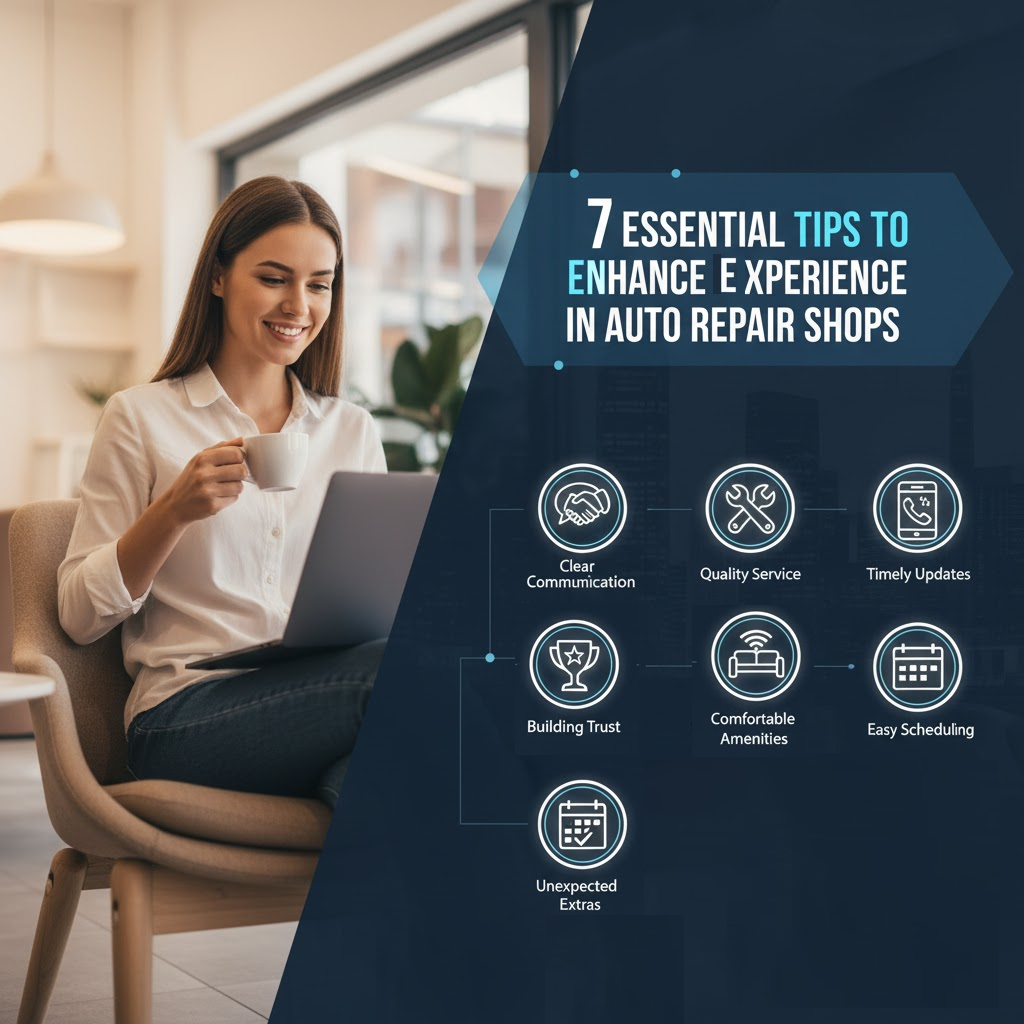In the competitive world of auto repair, delivering a superior customer experience can make all the difference between a one-time visit and a loyal customer. Whether you’re servicing an oil change, diagnosing car warning lights, replacing transmission cooler lines or performing full brake repair, every step of the process reflects on your shop’s reputation. Here are seven practical tips to elevate your customer service and build long-term trust.
Table of Contents
Toggle1. Communicate Openly and Clearly
Customers may come in because a dashboard light or other signal alerted them to a problem. When they mention something like vehicle dashboard symbols lighting up, they’re already worried. It’s critical for your team to explain what’s going on in understandable terms—not hidden behind mechanic-jargon.
Why it matters:
- Customers feel valued when you listen to their concerns and respond with empathy.
- When you explain issues like why the transmission fluid change is needed or why those transmission cooler lines need attention, you help them make informed decisions.
- Transparent communication reduces surprises and builds trust.
How to do it:
- Offer a brief diagnosis summary along with photos or video of the issue.
- Avoid overly technical language: instead of “EGR valve malfunction”, say “the engine’s exhaust recirculation system is working harder than usual and could lead to engine performance issues”.
- Set realistic expectations for timing and cost up front and provide updates if anything changes.

2. Make the Customer’s Convenience a Priority
For many drivers, bringing in their car for service is an interruption to their routine. Whether they’re coming in for a routine oil change or discovering car warning lights they’ve ignored, time is precious.
Why it matters:
- Faster service and fewer hoops to jump through lead to higher satisfaction.
- Offering conveniences contributes to a positive experience and increases the chances they’ll return.
How to do it:
- Provide online booking or text alerts on service status.
- Offer shuttle or loaner car options if major repairs (e.g., transmission fluid change or major brake repair) will keep them without a vehicle for hours.
- Design a comfortable waiting area: WiFi, seating, coffee; even if the customer stays for the repair, their comfort counts.
3. Build Trust Through Transparent Pricing and Estimates
No one likes surprise bills—especially in the automotive repair world where repairs (such as replacing transmission cooler lines or performing a major car repair) can feel expensive.
Why it matters:
- Clear, upfront costing removes anxiety and suspicion.
- Breakdown of labor, parts, and your explanation of what’s needed helps build credibility.
How to do it:
- Provide written or digital estimates before work starts, including what the service covers (e.g., oil change, transmission fluid change, auto AC repair).
- If an additional fault is found (for instance during inspection of the transmission lines or brake system), pause and call the customer with the updated estimate, explaining why the extra repair is needed.
- Avoid over-selling unnecessary services—stay honest.
4. Educate the Customer on Their Vehicle’s Needs
Many drivers don’t fully understand the significance of issues like vehicle dashboard symbols, or the need for servicing something like transmission cooler lines. By educating them, you empower them—and that makes them feel respected rather than sold to.
Why it matters:
- Customers who understand the “why” behind services are more likely to approve needed work and trust their provider.
- It positions your shop as an expert partner rather than just a service vendor.
How to do it:
- Offer short explanations or visual aids: “When this dashboard light comes on, it often indicates that the cooling for your transmission may be compromised, which is why we inspect the transmission cooler lines.”
- Provide basic insight into maintenance intervals: for example when to schedule an oil change, why auto AC repair may be needed, or when brake repair is critical.
- Offer preventive suggestions: “If we catch this now we can avoid bigger costs later.”
5. Provide Consistent Quality in Every Service
From a simple oil change to large-scale car repair, consistency matters. A customer needs confidence that the same high standard applies every time — not just when they’re paying premium rates.
Why it matters:
- Consistency fosters loyalty.
- A sloppy or inconsistent job can undo trust very quickly—especially when it involves safety-critical components like brakes or transmission systems.
How to do it:
- Standardise your procedures: every vehicle gets a courtesy inspection (regardless of service type), check the brake system, check transmission cooler lines, confirm warning lights.
- Keep the workshop clean and organised—first impressions matter.
- Use quality parts and materials for every job.
- Have your technicians and service advisors stay up-to-date on technology/training so they truly understand evolving systems.
6. Follow Up and Build the Relationship
The service doesn’t end when the vehicle drives away. Following up shows you care and want the long-term business, not just the transaction.
Why it matters:
- It increases retention and referrals.
- It turns one-time customers into repeat clients who think of your shop first when they see a dashboard light or need their auto AC repair.
How to do it:
- Send a friendly check-in email or text a few days after the service: “How’s everything driving since your brake repair?”
- Offer next-service reminders: e.g., “Your next oil change is due in approx. 5,000 km” or “We recommended checking transmission fluid in six months.”
- Recognise loyalty: maybe a small discount, or priority booking for repeat customers.
7. Use Technology to Enhance Experience
Technology is no longer optional—it’s expected. Whether it’s online booking, digital inspections, or real-time status updates, embracing tech elevates the customer experience.
Why it matters:
- It modernises the service and meets customer expectations for communication and convenience.
- It fosters transparency – digital inspection photos/videos showing problems like worn brake pads, transmission cooler line leaks or car warning lights help eliminate doubt.
How to do it:
- Implement digital inspection tools and share findings with customers via email or text.
- Offer online scheduling and reminders for services like oil change, transmission fluid change, etc.
- Provide mobile payment options, digital receipts and perhaps app-based loyalty tracking.
Conclusion
Improving the customer experience at your auto repair shop isn’t about flashy gimmicks—it’s about consistent, honest, customer-centric service. From the moment a driver notices vehicle dashboard symbols or the transmission cooler lines need inspection, to when they leave after a routine oil change, every step communicates whether your shop values their time, trust and safety.
Ready to raise the bar in your service delivery? Schedule a consultation or call us now to see how we can help transform your customer experience—book your next service with us today.
Frequently Asked Questions (FAQs)
- What should I do when my vehicle dashboard symbols come on?
When dashboard symbols appear, it means your vehicle’s monitoring system has detected an issue. Bring it in promptly so the technicians can diagnose whether it’s something like a sensor fault, wear-and-tear or a warning tied to bigger repairs like brake repair or transmission cooler line issues. - How often should I change my transmission fluid?
This varies by vehicle make and driving conditions, but many manufacturers recommend every 60,000 km or around every 4–5 years. If your technician also inspects the transmission cooler lines and finds signs of wear or leakage, they may recommend earlier service. - Can I wait to have brake repair until it starts making noise?
It’s not advisable. Waiting until noise begins means the pads may already be worn too thin or the rotor could be damaged. Early inspection helps avoid major repair costs and ensures your safety. - Why is it important to get an oil change regularly?
Regular oil changes remove contaminants, maintain engine lubrication and prolong the life of your engine. Neglecting oil changes can lead to overheating, increased wear and potentially major engine repairs. - How do I know if my auto AC repair is needed?
Signs include weak cold air, strange smells, louder than usual compressor noises, or the AC not reaching normal cooling temperatures. Bring the vehicle in and the technician can check refrigerant levels, belts, filters and identify any systemic issues.









